Greetings!
Welcome to Scifi-Meshes.com! Click one of these buttons to join in on the fun.
Quick Links
3DOrbital Combat Satellite
 psCargile417
Posts: 620Member
psCargile417
Posts: 620Member
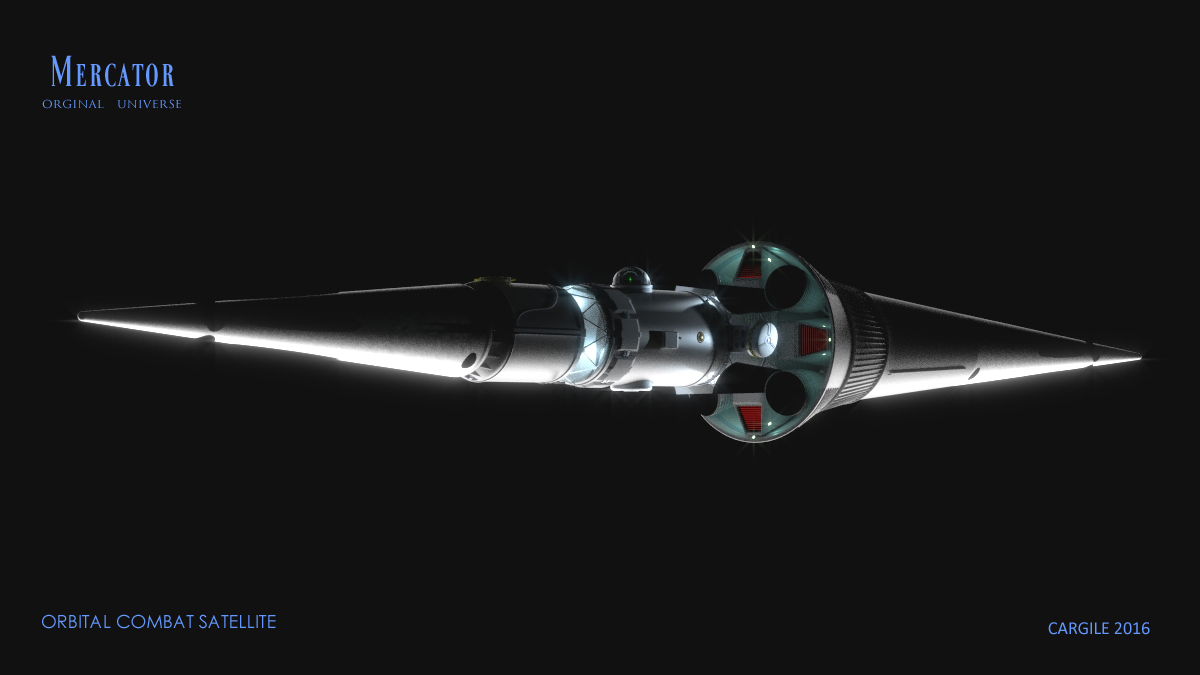
That orbital mechanics are nonintuitive, is an understatement. Balls thrown from a space station don't behave as you'd think. And as Atomic Rockets reminds us, ships are made to move and operate in water and that's why they look the way they do, aircraft are made to move and operate in the air and that is why they look the way they do, and spacecraft move and operate, not so much as in a vacuum, but in a gravity well, and they don't have to look like ships or planes at all.
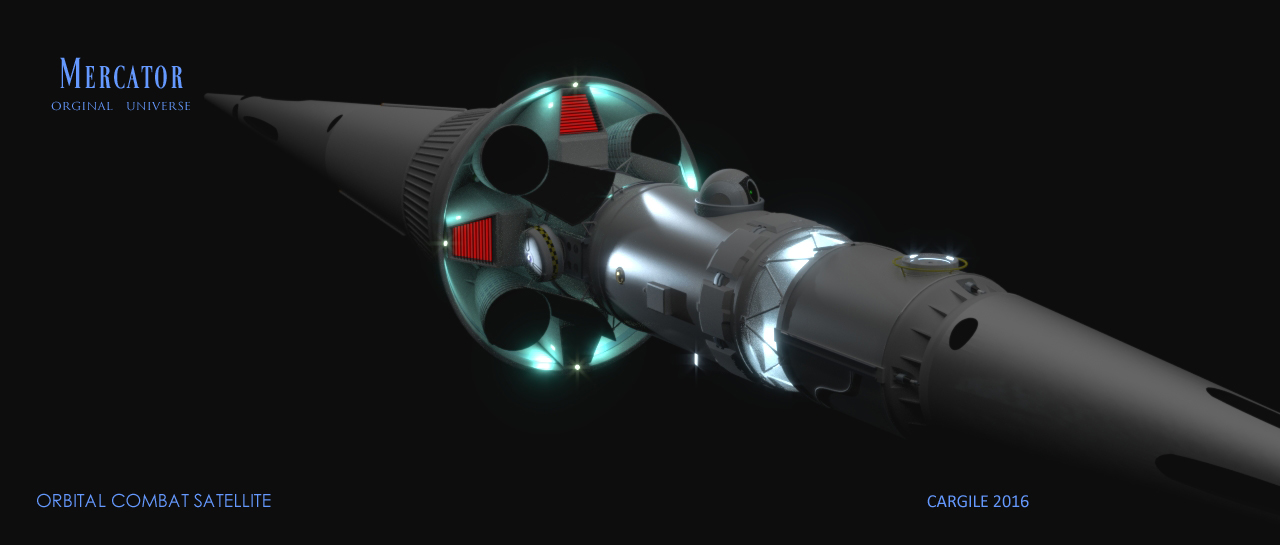
We tend to think that lighting off the main engines is going to make our spacecraft move faster. This is certainly true. But doing so is also going to change the shape of your orbit, and as any Orbiter jockey knows, when you burn, you watch what happens to your perigee or apogee. I've come to think as engine burns as controlling where those two nodes are in the orbit. If you drop your perigee when at apogee, and circle out your orbit by dropping your apogee at your new perigee, you are in a lower, faster orbit. The ISS moves fast. The moon does not.
What's all this yakkety yak got to do with orbital fighters? If you want to chase a target, you gotta get low. Or you can go high and slow and wait for them to pass under you, whatever the best option is, but you do want to be able to go lower than your target to have that extra advantage if you need it.

To get low, to get really low, you might just want to dip into the mesosphere--so long as you got the juice to get back out. This particular combat satellite for the original universe I've been steady diddling with for years, Mercator--as I now call it after the principle planet of action-adventure--is based on the Redding Space Plane (see this too!)
As I want to keep my science fiction a tad bit hard, I don't use any force field shields, so spacecraft engaging in combat under those rare situations where someone slips up enough to get into a position where shots can be traded, spacecraft have to block, shoot down, or evade impactors, be they physical or pulse trains of laser bursts. Not wanting to pay a high stipend in mass penalties for dense armor plating, I opted for rapid rotation rates and translation acceleration. I wanted the CG as close to the geometric center as possible, and using the law of the lever, placed the pitch and yaw thrusters as far away from the CG as possible so that the thrusters have a bigger push than if they were placed near the CG, saving on propellant and thus increasing the effectivity of the craft as surviving fighter.

The planet Mercator is roughly 33,000 lightyears away in the Centaurus constellation, events happening there at some undetermined far future time in which civilizations have risen and fallen, which means the technology level isn't going to be an exact extrapolation from ours. I like to use nanotech and computronium, and though there is all sorts of advanced propulsion, near instantaneous wormhole travel makes all spacecraft within certain size parameters orbital craft. There is warp drive as well, and also repulsive gravity whose effects I treat more like a thrusting force than a shield against attractive gravity. However, there is no FTL communication. And the line between man and machine is blurred with the near universal use of neuro-somatic symbiotic implants that acts as not only as a second nervous system, but replaces every gadget for social media and computer interfacing we use today, colloquially called a "weave"--as it is interwoven throughout the body--and heavily influenced by "Ghost in the Shell". It's this kind of technology that gives the ship is rather smooth and I'm-too-lazy-to-greeble-the-hell-out-of-it look. I prefer to know what my greebles do anyway.
Modeled in Blender, and rendered in Cycles...I can't tell you exactly how the thermal control units work, but what little waste heat the very efficient systems use is directed to these four units and radiated overboard. I imagine some kind of metamaterial is allowing for IR cloaking and channeling, and maybe some quantum teleportation of energy states, or some such. But anyway, I'm putting the Blackbody attribute to use on my emission shader for a reasonable amount of degrees kelvin, nothing over 900K and I usually have it set to 520K. I don't know how Blender is supposed to calculate things, but a Strength setting of 1 always looked too bright. Plus it's only going to really glow when that laser is firing its rapid pew pew pews.
The anti-g units are primarily used as boosters, and given the extra equipment rails and rack, they are add-ons. Since the fighter is designated a satellite, it's meant to stay in orbit, either operating autonomously, or piloted when needed if assigned and docked to a station. In those rare cases when it is grounded, a little extra push is good for getting back up into the black.

Here the craft is quantum locked in Valhammra Cosmospace's showcase berthing cradles.
The astronaut mesh I found on a NASA site free to the public. It is only for scale, as counter-pressure suits are likely to be the future, and I'm working on a pilot to replace the hapless bulky figure. Landing gear? Dirigibles lack them too.
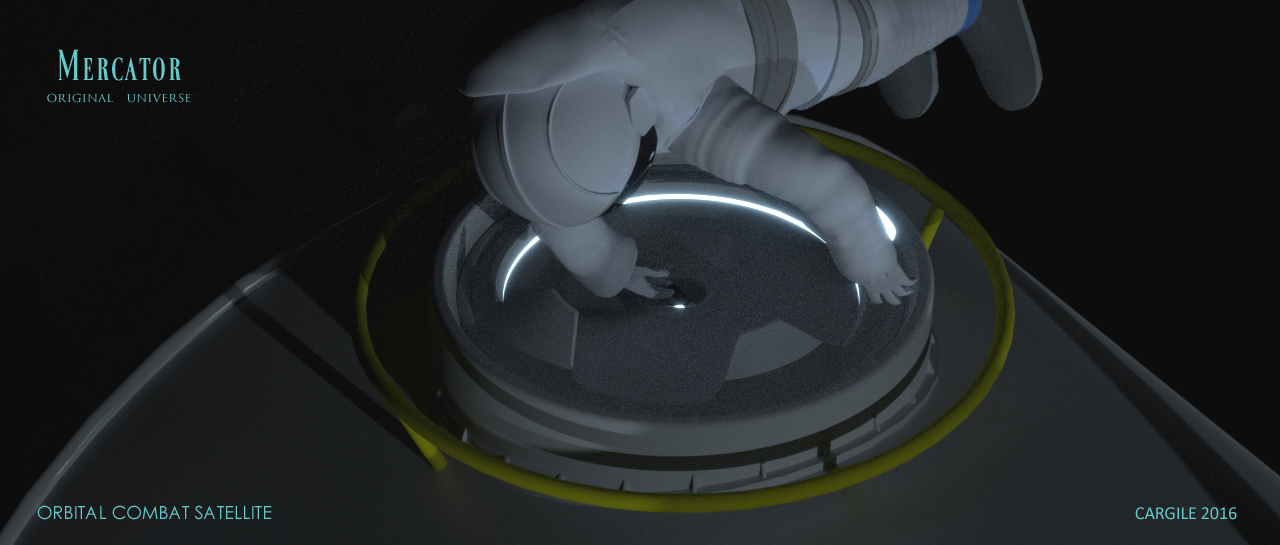
Here a distraught pilot has to resort to using the manual control of all things to operate the hatch because he has lost connectivity to the ship. The hatch is likely a hinge-less plug type with smart-matter elements. I'm still working on the inside of the hab module.
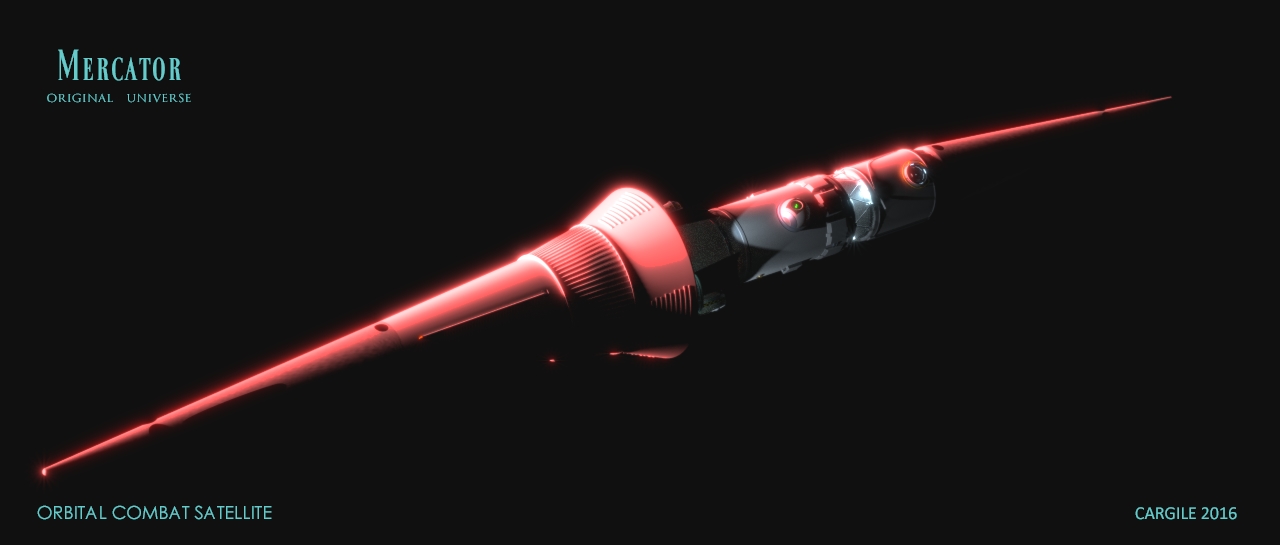
Mercator orbits a red giant, so pink sunlight. Blender developers claim that the Strength of Sun Lamps is in watts per square meters. Based on the specs of my star and the 25 AU distance of Mercator, I calculated (Okay, the spreadsheet did) over 6500W/m^2 on a surface at Mercator, which seemed too bright, so I don't know if my math is wrong, or Blender is doing it different, or if it is correct. I took it down to 6.5.
Oh, wait, I found websites that give the solar illumination for here on Earth and the figure plugged into Blender seemed too bright. I just bring it down to a level that looks right.

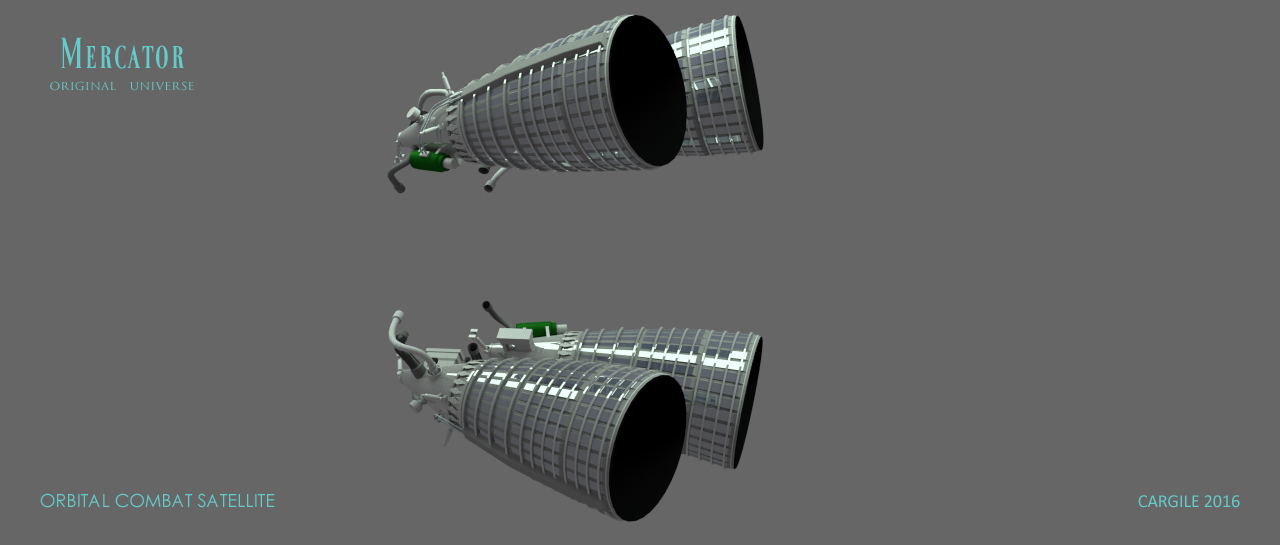
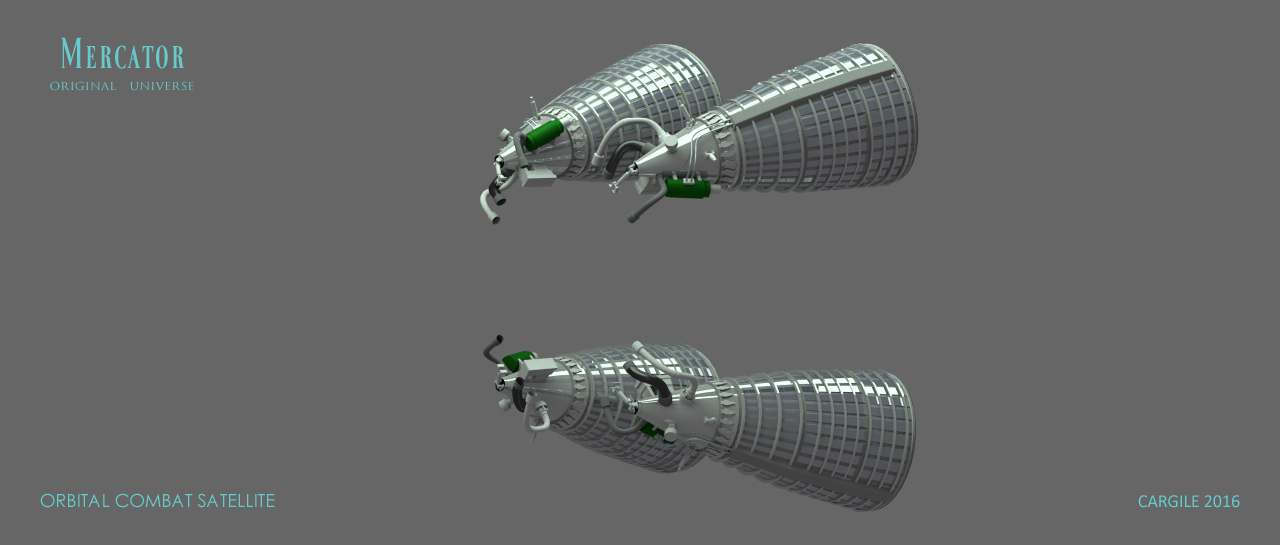
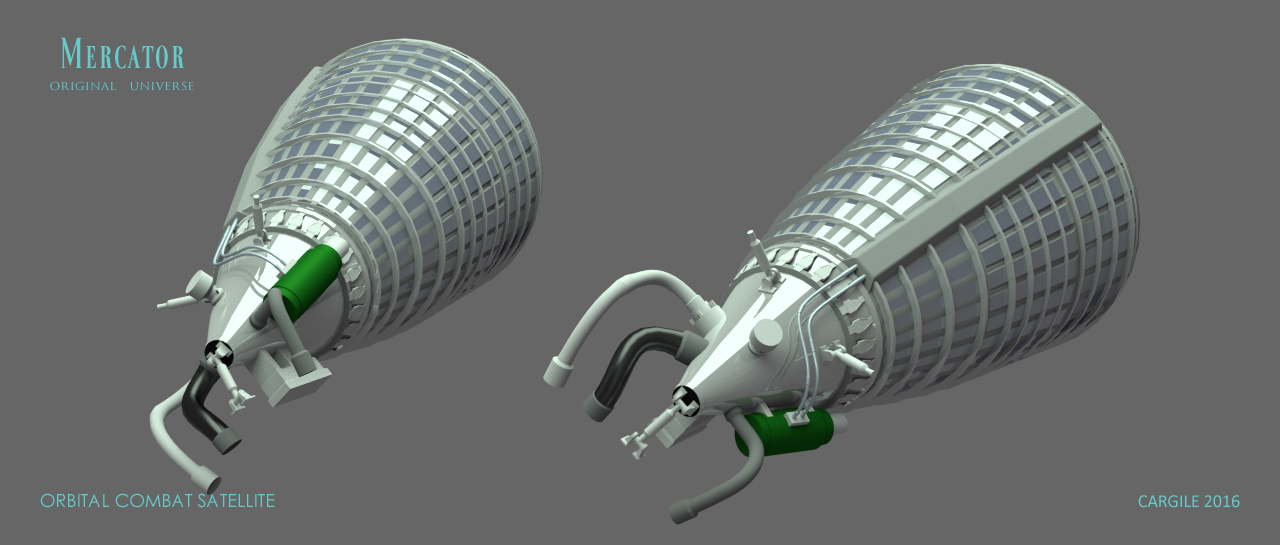
If you look at pics and diagrams of real engines you'll soon realize this is about as much detail as I wanted to do.
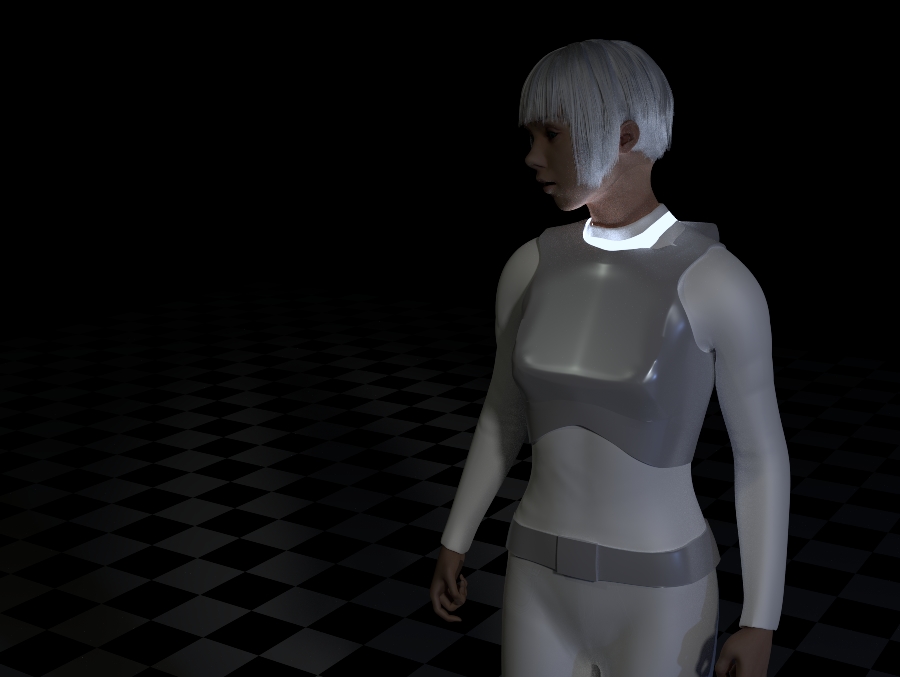
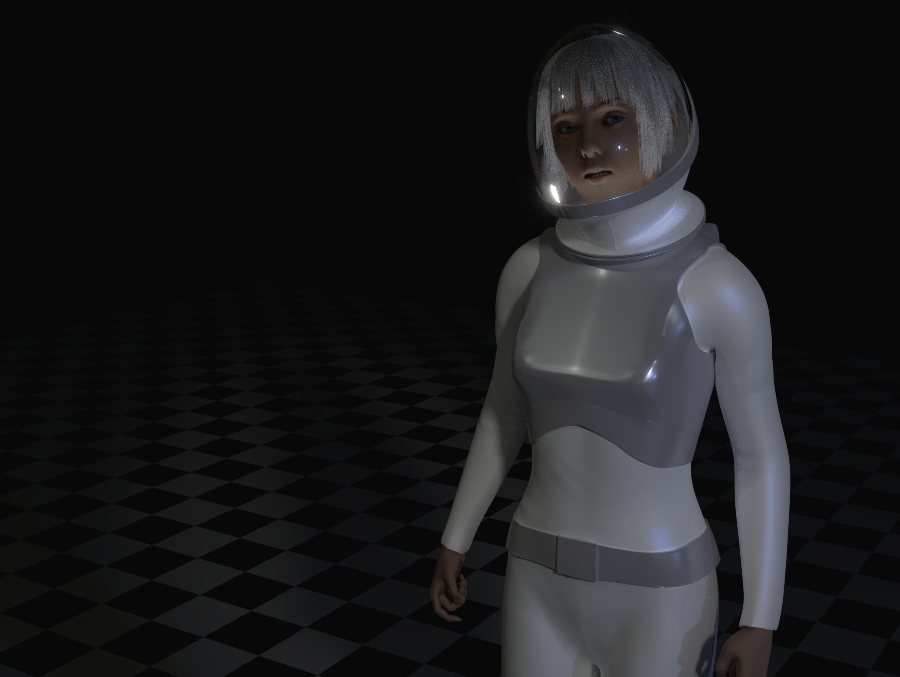
Here's the pilot, done up in MakeHuman (I wish they would include the face morphs like the old version had) and imported into Blender. When I finish with her counter-pressure suit, I'll apend her to the fighter model.
This is the third helmet pass. I had used spheres for the first two, but there were problems, so I used a curve, made it a tube and extended it, and switched it to a mesh and started extracting. I did use a sphere for the glass. The torso piece isn't the best. You would think taking a pair of breast and making them a rectangular cube would be easy...I reached a point where I was tired of ***king with it. The collar ring was originally once smaller...and impossible to pass a head through.
The fighter model is mostly finished. At this point I consider it done, the only thing left is the interior, and I haven't been in a hurry of late to work on it (went back to work on my Trek fanfic I started last year), so it might get done, it probably wont. Windows? I'm iffy on. The optic arrays embedded in the hull give the pilot a direct feed through the pilot's weave, so the pilot can see all around anyway. And if so many get destroyed as to blind the pilot, she has more stressing problems to worry about. The only real use for a window would be for others to see inside during an emergency, but the flight deck is in the middle of the hab, so no one will actually be able to see the pilot anyway. Plus I can't put a window in there until I have the interior planned.
Been working on this much of last year, renders take from anywhere from around 30 minutes to around 3 hours. You know how it goes, render, don't like it, change things, render again, don't like it, play with stuff, render while sleeping, get up to pee, look at finished render, don't like it, close it down, there is always tomorrow. And the next, and the next after that.
And now that have completely exhausted your attention span, if you want to have some idea of how I see this fighter used, I have written a storyboard outline that's fast paced and to the point, with five rough panel drawn at the end. http://cargile.tripod.com/OrbComSat/protector_of_the_source.pdf
Questions? Ideas? Coal raking?
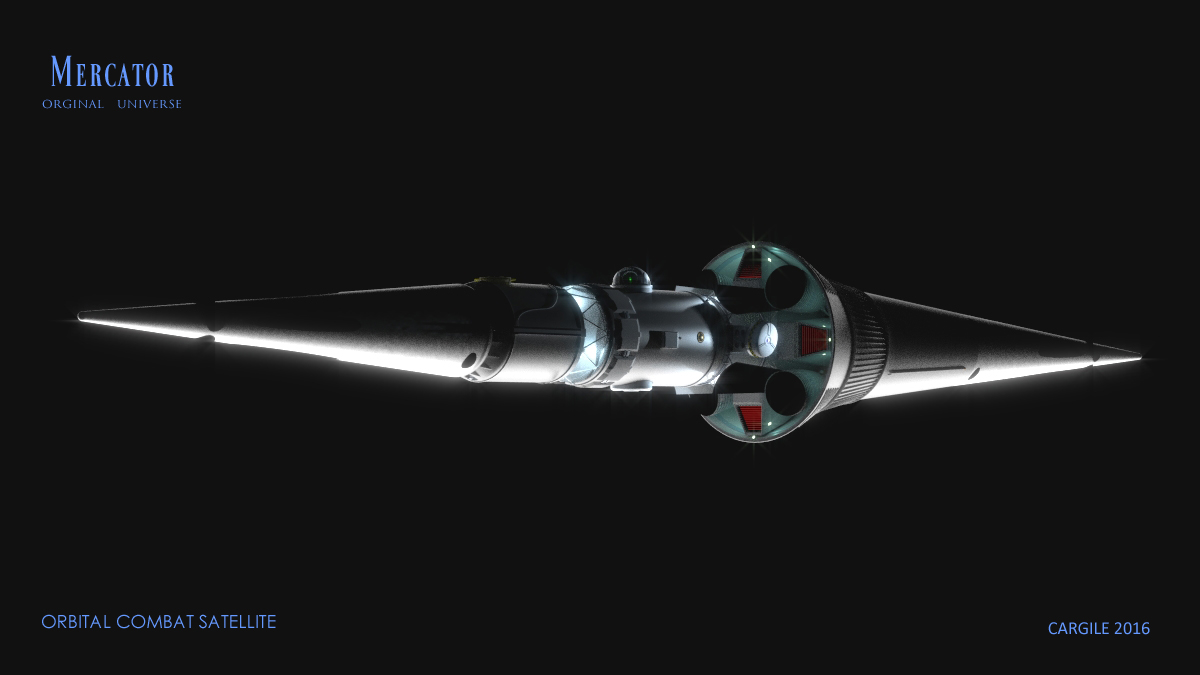
Post edited by psCargile on
Tagged:
Additional credits
- Icons from Font-Awesome
- Additional icons by Mickael Bonfill
- Banner background from Toptal Subtle Patterns
© Scifi-Meshes.com 2001-2024
Posts
Is detection, pursuit and targeting performed by the crew, or considering the complexities of targeting orbital objects on various trajectories, are those ops automated? Or is the tech woven through the crews bodies enough to make them react and calculate sufficiently to manually operate this?
Do these weapons operate in swarms, and are they deployed from a larger support craft in orbit? Are these interceptors for planetary border security? Changing orbits and trajectories takes a lot of energy, what is their range/mission duration?
I like the squid-like torpedo appearance of this craft.
If I were to do a present or near future design of the same concept, I'd take the Redding planform, with a fixed laser system taking up the body of the fuselage--no turret, just a shuttered window for the aperture-- and use nuclear propulsion for both laser power and thrust. I wouldn't use a dual cone planform like I have here, and it wouldn't be manned. However, I think as far as realistic orbital fighters go, the Boeing X-37 is a strong candidate.
It would be nice if Blender had controls specific for science fiction or aerospace effects. I can make thrust jets using a particle system in the regular renderer, but not haven't figured out how to do that in cycles. I've played around with fire but it didn't look satisfactory. I have to play with it some more.
Interior work.
This configuration has a laser module. Other configurations would have different weapons. And, well, it only has to travel along the long axis when performing orbit changing engine burns or flying through the upper atmosphere where drag will be a consideration, otherwise any orientation is as good as another.
If a sensory infrastructure exists in orbit or on the ground, it can link with that, and that information is sent to the pilot. Depending on the pilot's personal tastes, this information can be presented within their visual field, or can be realized as direct knowledge--the pilots knows where and what the target is without having to actually see it. It can be a fully autonomous where a pilot isn't needed (as in most cases due to the longevity of phasing orbits), or a pilot is there only to make overriding decisions, or it can be shared, or if the pilot is an egotistical hero, all manual with the caveats that introduces. If there is no support infrastructure, it's dependent on it's own sensor arrays, which in space, passive visual and IR has greater range than its radar.
All these are possible. I haven't nailed down the exact propulsion method, but I've leaned toward metallic hydrogen as a possibility, and it could be anything but ion. Range and duration is all dependent on specific impulse and delta v budgeting, but I think it's more useful if it restricted to a narrow orbital range where it will have more delta v available. In the outline I provided, an asteroid is protected by a single fighter, but there are numerous and similar servicing stations arrayed in an outer orbit to minimize delta v--always something close by to dock too, but this situation is special to the story.
Got to love it. Started render around 11:30 PM, got up before 5:30 AM, render was almost finished. Had to stop it and process the composition.